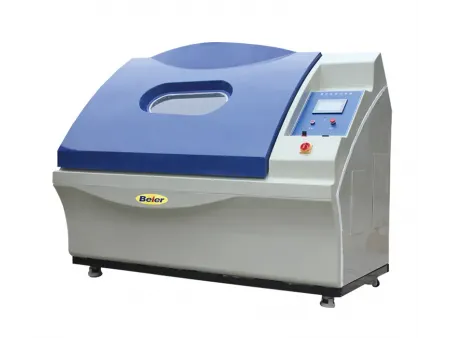Salt Spray Test Chamber
Environmental test chamber used for testing the corrosion resistance of products
- Pioneering Cyclic Immersion Corrosion Testing: As China's first company to introduce cyclic immersion corrosion test chambers, Beier Labs successfully transcended the limitations of traditional single-immersion testing. We've integrated and enabled simultaneous operation of four distinct test methods: cyclic immersion, full immersion, partial immersion, and spray. This innovative design significantly boosts experimental efficiency and provides users with a more comprehensive, efficient, and precise solution for corrosion performance testing!
- 22 Years of R&D Expertise & Customization: With over two decades of dedicated technical research and development experience, Beier Labs offers extensive customization options for our equipment to meet specific customer requirements. We are equipped to bring virtually any experimental testing concept to fruition through our tailored solutions.
Standards
Salt spray test chamber complies with standards: GB/T14293, GB/T10587, GB2423.17.
Salt spray test chamber is mainly used to simulate and perform the accelerated corrosion test on materials or products by salt-containing solutions or acidic salt-containing solutions in an artificial simulated environment. It can be used to test the extent of damage suffered by materials or products over a certain period of time, allowing for the rapid evaluation of the corrosion resistance performance of products and the assessment of the material corrosion resistance situation and improvement schemes.
Additionally, the equipment can simulate different environments, such as high temperature, low temperature, humidity, etc. By testing under different temperature environments, the durability and performance of the product can be comprehensively evaluated. In summary, the salt spray test chamber is an extremely important experimental equipment that can effectively simulate various corrosion effects in natural environments, providing industries with an efficient and reliable means of quality control.
Semiconductor devices need to operate in high-temperature, high-power, high-frequency, and corrosion-resistant environments. Therefore, they must undergo testing in the salt spray test chamber to verify their reliability. In the automotive industry, salt spray test chamber is used to test the corrosion resistance of automotive components to ensure stability and durability in actual use environments.
- The outer and inner shell of this salt spray test chamber (including acid salt spray test chamber) is made entirely of PP (polypropylene) material, fully welded. There is absolutely no leakage. Other accessories are made of stainless steel, copper, or corrosion-resistant, high-temperature-resistant materials.
- Chamber Lid: The lid is made of PP board, designed with a 110-120° angle to prevent condensation from dripping directly onto test samples. The lid uses a water-sealed structure to ensure no salt spray escapes, and there's no splashing when the lid is closed. The observation window at the front is integrated with the lid, welded as a whole. The observation window measures approximately 300×250mm and features a double-glazed design with anti-frost coating.
- Lid Support: The lid is supported by a pneumatic cylinder for easy opening and fixing, and when closing, it slows down the speed to prevent sudden impact. The metal rods around the cylinder are coated with corrosion-resistant sleeves to prevent rust and extend lifespan.
- Water-sealed structure, no salt spray leakage, tower-type spray system, even distribution of salt spray, adjustable sedimentation levels, and crystallization-free nozzles.
- To ensure uniform salt spray distribution, the spray tower includes a conical disperser to direct the spray and adjust both the spray volume and the even distribution of the sediment. The saturated air tank is heated according to Henry's law to provide the necessary humidity for the test chamber.
- The saturated air tank is made of high-quality SUS304 stainless steel, and the heating component is made of advanced titanium alloy tubes.
- Saturated Tank: Made of SUS304 stainless steel with an automatic water-filling feature.
- Equipped with height-adjustable universal heavy-duty casters for easy movement and fixing of the equipment.
- Spray System: Equipped with specialized glass nozzles, a saltwater tank, spray tower assembly, air saturation generator, key pneumatic components, air pressure regulation, spray pressure adjustment, salt spray collection devices (standard funnels and graduated cylinders), strong exhaust device, drainage system, and waste liquid recycling and treatment system.
| Temperature Range | RT 5℃~55℃ |
| Saturated Air Barrel Temperature | RT 10℃~70℃ |
| Temperature Range | 30-98%RH |
| Spray Deposition | 1-2mL/80cm²·h |
| Temperature Deviation | ±2℃ |
| Humidity Deviation | 2%, -3% R.H |
| Temperature Fluctuation | ±0.5℃ |
| Spray Type | Continuous / Periodic (optional) |
What factors influence salt spray testing?
What is the difference between a composite salt spray corrosion test chamber and a traditional salt spray test chamber?
- Traditional Salt Spray Test Chamber: Primarily simulates a singular salt spray environment. Due to the limited environmental simulation, test results may not fully reflect a material's corrosion behavior in complex real-world conditions. It is suitable for testing materials and products with relatively straightforward requirements for a salt spray environment, such as assessing the corrosion resistance of ordinary metal products. These tests typically comply with standards like ASTM B117, ISO 9227, and others.
- Composite Salt Spray Corrosion Test Chamber: In addition to salt spray functionality, these chambers integrate multiple environmental simulation capabilities such as humid heat cycling, drying, and condensation. They can achieve alternating cycles of environmental conditions including salt spray, high temperature, low temperature, high humidity, and drying. This makes them suitable for simulating more complex working conditions, such as corrosion resistance and reliability testing for automotive components, aerospace materials, and electronic components under various environmental factors. These chambers are equipped with data monitoring and recording systems, allowing for real-time tracking of various parameters during the test, which facilitates analysis and traceability. They adhere to more complex cyclic corrosion standards like GMW 14872, SAE J2334, among others.
